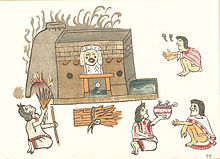Temazcal
The Temazcal or Temazcalli is a steam bath that has been documented by archaeological finds throughout the Mesoamerican region and is still in use today. The purpose of this facility was and is less in the ceremonial or "wellness", but primarily in the therapeutic, that is, to cure illnesses. The name comes from the Aztec , temas means bath, calli means house. The Yucatec name is zumpul ché . As a rule, these buildings are relatively small and low with space for one to a maximum of ten people, but there are also indications of large structures from earlier times.
history

The tradition of Temazcal can be proven by finds from pre-Hispanic times from the Mayan area. It was not an Aztec invention as the temazcal was known to the Purépecha before the Aztecs immigrated . The patroness of the sweat baths in Tzintzuntzan was the moon goddess Xaratanga. During excavations in Piedras Negras eight structures were discovered on hills, which are interpreted as sweat baths. So the tradition of the steam bath was known in this area even before leaving the city. A T-shaped structure in Chichén Itzá was also interpreted as a sweat bath by Ruppert as early as 1936. The reconstruction of a structure from Piedras Negras shows a kind of bath house that is reminiscent of Roman examples. There are also references to Temazcals among the Mixtecs of the post-classical period .
At the time of the Conquista , the temazcal was widespread throughout the Mesoamerican region. Clavijero wrote: "There is no place, however small it may be, that does not have many."
Description and functionality
A. Barley describes the temazcal as a type of domed and circular mud-brick oven eight feet in diameter and five to six feet high. There is an opening at the top. The bottom is slightly convex and is a foot above the ground. The Temazcal is entered crawling through a narrow door. Opposite the entrance is the stone or adobe fireplace, which is connected to the Temazcal by a common wall called tetzontli or other porous stone. When the fireplace is hot, the patient enters the temazcal, closes the openings and pours water on the glowing tetzontli, lies down on a mat and beats medicinal plants or corn leaves soaked in hot water on his body.
After sweating, the patient runs out of the Temazcal and jumps into a stream or pond to cool off. The very sick suffered T. circulatory collapses and died. On the other hand, there have been reports of successful healings from lumbago and sciatica, as well as the positive prenatal and postpartum effects in pregnant women. The worldview of the Mesoamerican peoples also played a role in the construction of a Temazcal. The fireplace was mostly oriented to the east, that is, in the direction of sunrise, while the entrance pointed to the south, symbolizing the "path of the dead" and thus perhaps also relating to the birth process.
Rejection by the Spanish conquerors
To the partially quoted statement by Diego de Landa that the Mesoamerican natives washed themselves regularly, even daily, Clavijero adds the observation that the use of the Temazcal was "only a little less frequent". Nevertheless, the Spaniards saw pagan rites in them, destroyed numerous Temazcals and initially forbade anyone who did not need them for healing. Later the use was made completely punishable: It is believed that the fact of the nudity contradicted the moral ideas of the Spaniards. Furthermore, there was no gender segregation in the Temazcals, which may have led to thoughts of orgies in an outsider. It has to be mentioned, however, that many Temazcals were very small and could only accommodate one person. The Spaniards must have been aware of this, which is why a misinterpretation of the function of larger Temazcals cannot necessarily be assumed, but also cannot be ruled out.
Above the entrance there was usually a picture of the "Mother of God" Teteo-Innan. Today one finds a picture of Mary in the same place. The goddess Teteo-Innan corresponds to the goddess Temazcalteci, the "grandmother of the baths". Their cult was also widespread among the Mixtec , Zapotec and Maya , which could indicate that the Spaniards forbade the Temazcals because they feared too strong a reference to pagan religion.
Using Temazcals Today
Since the 1950s, interest in the old temazcal has been rekindled. Today these are mainly operated by women, the temazcaleras , who also make the diagnosis and then decide which temperature, humidity, height positioning of the patient and herbs to choose. During the treatment, they fan hot air to areas of the body that need special heating (e.g. for back pain).
By the way, sweat baths similar to the Inipi can also be found in North and South America. However, the pronounced medical function seems to be limited to the Mesoamerican region.
See also
literature
- Horacio Rojas Alba: Temazcal. The Traditional Mexican Sweat Bath. available at: http://www.tlahui.com/temaz1.html
- Linton Satterthwaite: Sweathouses. 1. Recognition of sweathouses at Piedras Negras: diagnostic traits and terminology. available at: http://www.famsi.org/research/piedras_negras/u_penn/index.htm
- Verónica Pérez Rodríguez: Household Intensification in the Mixtec Cacicazgo: Excavation of a House and Terraced Fields. available at: http://www.famsi.org/reports/01027/index.html
- Heinrich Wallnöfer: The doctor in Mexican culture. Stuttgart 1967.
Web links
- Experiencia de Temazcal en Chile
- ¿Que es un TEMAZCAL? Video (youtube)
- ¿Qué es, para qué y por qué necesitas un Temazcal? Video (youtube)